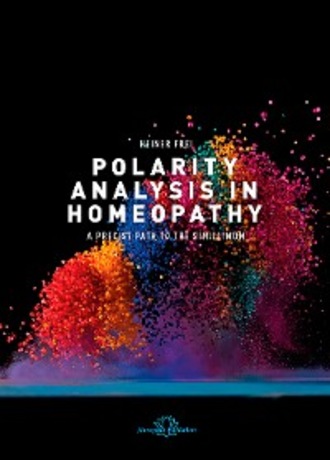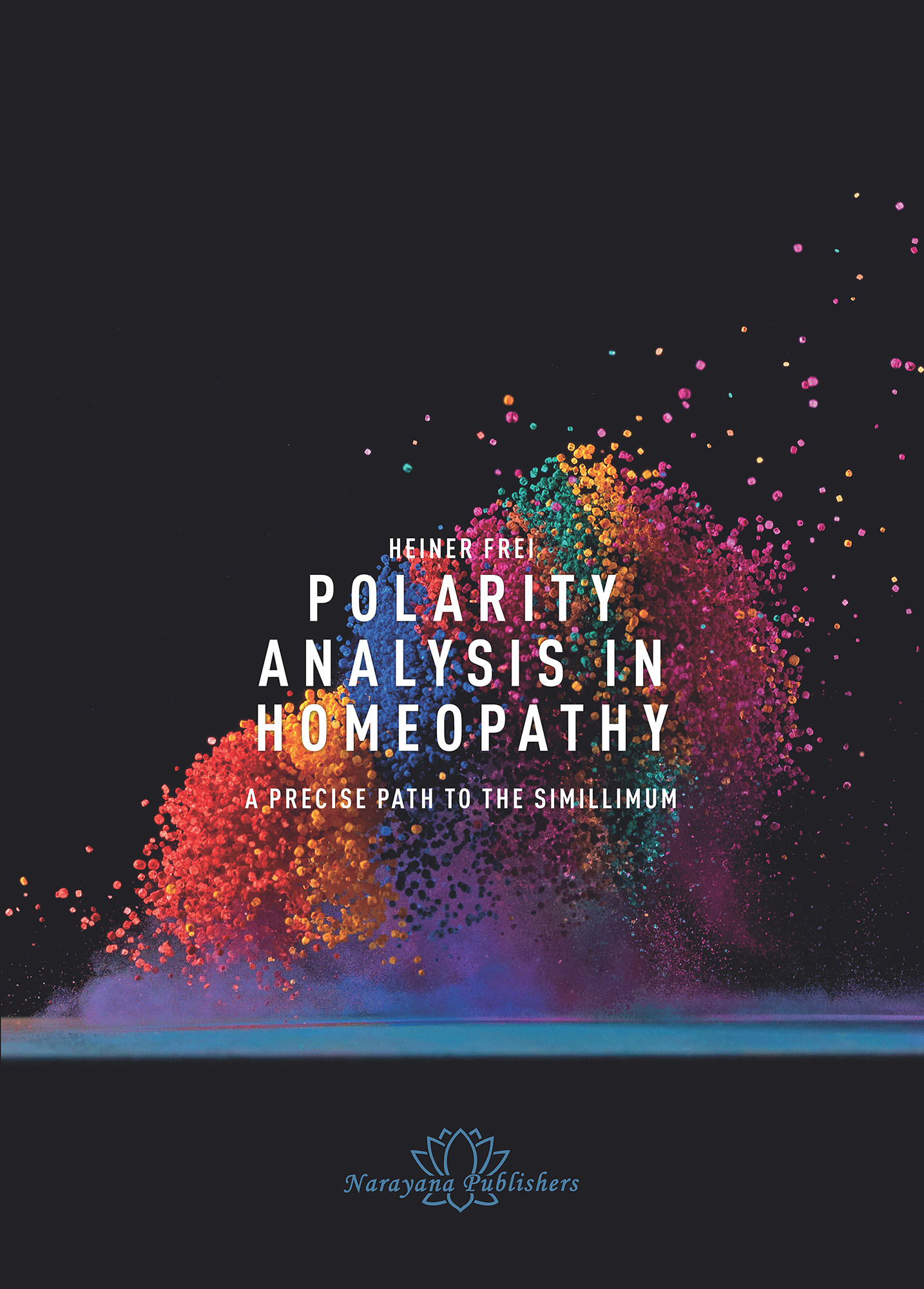
Полная версия
Polarity Analysis in Homeopathy:


HEINER FREI
POLARITY
ANALYSIS IN
HOMEOPATHY
A PRECISE PATH TO THE SIMILLIMUM

POLARITY ANALYSIS IN HOMEOPATHY
A Precise Path to the Simillimum
by Heiner Frei
ISBN 978-3-95582-230-9
First English Edition 2013
Second English Edition 2017
© 2013 Narayana Verlag
NARAYANA VERLAG
Blumenplatz 2, 79400 Kandern, Germany
Phone +49 7626 9749700
info@narayana-verlag.com
www.narayana-verlag.com
All rights reserved. No part of this book may be reproduced by any mechanical, photographic, or electronic process, or in the form of a phonographic recording, nor may it be stored in any retrieval system, transmitted, or otherwise be copied for private or public use without the written permission of the publisher.
NOTE:
In spite of the extreme care taken over the production of this book, it is possible that you may find mistakes for which we cannot be held responsible, or which may be nothing more than a misinterpretation of the information provided. The aim of this book is to guide the reader in their attempt to find balance and health through homeopathy, but it should in no way be a substitute for the advice or opinion of a qualified doctor.
Cover Photo: Fabian Oefner
Design: Chragokyberneticks
Typefaces: Ideal Sans & Din
TABLE OF CONTENTS
ABBREVIATIONS
IMPROVING HOMEOPATHIC PRESCRIBING - A PREFACE
ACKNOWLEDGEMENTS
MODULE 1
1. POLARITY ANALYSIS
1.1 Introduction
1.1.1 History
1.2 Principles of Homeopathy
1.2. Hahnemann’s Concept of Illness and Symptoms
1.2.2 The Law of Similars
1.2.3 Hierarchy of Symptoms
1.2.4 Reliability of Symptoms
1.2.5 Hering’s Law
1.3 Quiz 1: Fundamentals of Homeopathy
1.4 Development of Polarity Analysis
1.4.1 Boenninghausen’s Contraindications
1.4.2 Polarity Difference
1.4.2.1 Case 1: Subacute Granulomatous Thyroiditis De Quervain
1.5 Casetaking and Choice of Remedy
1.5.1 Checklists and Questionnaires
1.5.2 Repertorisation
1.6 Quiz 2: The Boenninghausen Method
1.7 Dosage
1.8 Assessing Progress
1.9 Practical Procedure
1.9.1 Case 2: Acute Hearing Loss
1.10 Contributors to the Development of Polarity Analysis
1.11 Quiz 3: Questions on Polarity Analysis
1.12 Summary
1.13 Discussion
2. ACUTE ILLNESS
2.1 Procedure
2.2 Case Histories
2.2.1 Allergy: Minor Remedy – Major Effect
2.2.2 Erysipelas: What if there is a lack of polar symptoms?
2.2.3 Infectious Mononucleosis (Glandular Fever): Dealing with an excessive number of symptoms
2.2.4 Tendosynovitis: Patient characteristics are not symptoms!
2.2.5 Obstructive Bronchitis: The significance of “childhood symptoms”
2.2.6 Gastroenteritis: The importance of the materia medica comparison.
2.2.7 Trigeminal Neuralgia: Ambivalence of the left right relationship of the remedies
2.2.8 Quiz 4: Acute Illness, Part I
2.2.9 Colic in Young Babies: Exact formulation of the symptoms is crucial!
2.2.10 Influenza: Effect of the remedy or spontaneous recovery?
2.2.11 Otitis Media: The significance of knowledge of the materia medica.
2.2.12 Laryngotracheitis (Sore throat and cough): Procedure for an intercurrent illness.
2.2.13 Tonsillitis After MMR Vaccination: Homeopathic treatment of vaccine side effects.
2.2.14 Epidemic Parotitis (Mumps): The significance of contraindications.
2.2.15 Upper Respiratory Infection: Carefully reading the materia medica
2.2.16 Scarlet Fever: Polarity difference is more important than the materia medica comparison
2.2.17 “The Snows Of Kilimanjaro” – Mishap on a Trip in the Mountains: How can “proven indications” be used in a rational way?
2.2.18 Quiz 5: Acute Illness, Part II
2.2.19 Working with Acutely Ill Patients
MODULE 2
3. CHRONIC ILLNESS
3.1 Procedure
3.2 Case Histories of Uncomplicated Chronic Illness
3.2.1 Soft Tissue Rheumatism: What are reliable criteria for choosing the remedy?
3.2.2 Irritable Bladder With Recurrent Cystitis: The connection between § 153 and § 133.
3.2.3 Bronchial Asthma: Distinguishing between the patient’s symptoms and conditions of nature.
3.2.4 Chronic Whiplash: The course of the “initial reaction”
3.2.5 Orthostatic Arterial Hypotension: The remedy provides insights into the psychodynamics.
3.2.6 Hyperemesis Gravidarum: Initial aggravation or remaining symptoms?
3.2.7 Lennox Syndrome – A Complex Form of Epilepsy: Possibilities and limitations of homeopathy.
3.2.8 Hay Fever: Do not rest on your laurels!
3.2.9 Quiz 6: Uncomplicated Chronic Illness
4. MENTAL ILLNESS IN CHILDREN AND TEENAGERS
4.1 Procedure Peculiarities of Mental Illness
4.2. Cases
4.2.1 ADHD: The value of pathognomonic symptoms
4.2.2 Crisis in Starting Working Life: The new stage of life requires a change of remedy.
4.2.3 Psychological Trauma: Polar physical symptoms identify the correct remedy.
4.2.4 Asperger Syndrome: Constitutional characteristics must be distinguished from symptoms.
4.2.5 Borderline Personality Disorder: Secondary symptoms can also indicate the correct remedy!
4.2.6 Trichotillomania (Compulsive Hair Pulling): Remedy pictures can deceive!
4.2.7 Conversion Syndrome (Hysterical Paralysis): Homeopathic healing or spontaneous remission?
4.2.8 Duchenne Muscular Dystrophy and its Consequences: Homeopathic care of an incurable illness
4.2.9 Quiz 7: Mental illness in children and teenagers
4.2.10 Working with Patients Who Have a Chronic Physical or Mental Illness
MODULE 3
5. MULTIMORBID PATIENTS
5.1. Procedure
5.2.1 Exhaustion Due to Stress Both at Work and in the Family: Criteria for selection of symptoms for repertorisation
5.2.2 Cardiac Syncope: Complications of an intermediate remedy
5.2.3 Anxiety Disorder: How to proceed when no remedy covers all symptoms.
5.2.4 Paroxysmal Visual Disturbance: The importance of graphical progress checks.
5.2.5 Chronic Fatigue Syndrome: Stress as an antidote to homeopathic remedies.
5.2.6 Concealed Depression: Subtleties of the materia medica comparison.
5.2.7 Quiz 8: Multimorbid Patients
5.2.8 Working with Patients who have ADHD/ADD or Multimorbid Illness
6 EVALUATION STUDIES OF POLARITY ANALYSIS
6.1 Acute Illness
6.1.1 Introduction
6.1.2 Design
6.1.3 Results
6.1.4 Discussion
6.2 The Influenza Epidemic of 2011: A Prospective Outcome Study
6.2.1 Introduction
6.2.2 Design
6.2.3 Results
6.2.4 Discussion
6.3 Chronic Illness5
6.3.1 Introduction
6.3.2 Design
6.3.3 Results
6.3.4 Discussion
6.4 ADHD/ADDStudy
6.4.1 Introduction
6.4.2 Design
6.4.3 Results
6.4.4 Discussion
6.5 Multimorbid Patients
6.5.1 Introduction
6.5.2 Design
6.5.3 Results
6.5.4 Discussion
7 TOOLS
7.1 Repertory
7.2 Acute Illness: Checklists
7.3. Chronic Illness: Questionnaires
7.4 Multimorbid Patients: Questionnaires, Case Logs, Progress Checks
APPENDIX
8.1 Quiz Answers
8.2 List of Tables
8.3 List of Figures
8.4 List of Pictures of Remedy Substances
8.5 Cases
8.6 Bibliography
8.7 Remedy Index
8.8 Subject Index
8.9 About Me
ABBREVIATIONS
ADHD Attention Deficit Hyperactivity Disorder ADD Attention Deficit Disorder BOWG Boenninghausen Working Group CC Complex Case CI Contraindication (CI) Relative contraindication CGI Conners’ Global Index CPRS Conners’ Parent Rating Scale CTRS Conners’ Teacher Rating Scale ENT Ear, Nose and Throat GS C. Hering, The Guiding Symptoms of Our Materia Medica MMP S. Hahnemann, Materia Medica Pura MMR Measles, Mumps, Rubella § Aphorism in S. Hahnemann, The Organon of Medicine (P) Polar Symptoms PA Polarity Analysis PB C. von Boenninghausen, Boenninghausen’s Therapeutic Pocketbook PD Polarity DifferenceIN OUR QUEST FOR THE ADVANCEMENT OF HOMEOPATHY, KNOWLEDGE, RATIONAL METHODOLOGIES AND IMPROVED OUTCOMES HAVE TO EVOLVE TOGETHER. — RUSSELL MALCOLM
IMPROVING HOMEOPATHIC PRESCRIBING — A PREFACE
“Repeat the experiments … repeat them carefully and accurately, and you will find the doctrine confirmed at every step.”
With these words Hahnemann urged his reviewers to practice homeopathy in an accurate manner (Materia Medica Pura [MMP], Vol. II, p. 2)1. Homeopathy has nevertheless developed in breathtakingly diverse directions since its discovery 200 years ago. When asked to find the best remedy for a particular case, the participants in a modern seminar will put forward a multitude of suggestions. For those less familiar with homeopathy, this generates the impression of considerable disorientation. In contrast, Hering reported in the middle of the nineteenth century that he had sent a patient’s medical history to 33 colleagues, requesting them to suggest the most suitable remedy. He received 22 replies, all indicating the same remedy.2 There was evidently at that time a widespread consensus about the procedure to identify the required remedy. In view of the recent aggressive and frequent attacks on homeopathy, the fact that the required remedy cannot be reliably and reproducibly determined has seriously damaged homeopathy. Most new methods that have been introduced to homeopathy since the beginning of the twentieth century have not been statistically evaluated: we therefore do not know how they affect treatment outcomes, a situation that should urgently be corrected with outcome studies. These would also be an important step for homeopathy to acquire the status it deserves in medicine.
Polarity analysis (PA) was developed for the scientifically rigorous Swiss double-blind study with homeopathic treatment of hyperactive children, a study which demonstrated a significant difference between high-potency homeopathic remedies and placebo.3 A fundamental challenge in reaching this result was to improve the reliability of all elements used to determine a remedy.4,5,6 The method of PA is based on Boenninghausen’s Therapeutic Pocketbook (PB) and its still unmatched grading of symptoms. Transferring the new insights to the treatment of acute and chronic illness as well as multimorbidity has led to a noticeable improvement in prescribing accuracy.
This book aims to convey the essentials of polarity analysis by providing the reader with a comprehensive practical introduction to this working method. We have included a wealth of case studies, chosen to illustrate the many different aspects encountered in clinical practice. We recommend that you try to reproduce the remedy selection process in these cases with one of the available software programs based on the revised edition of Boenninghausen’s Therapeutic Pocketbook (PB).7 The author uses the repertory program of the Boenninghausen Working Group (BOWG).8 Once you have understood the new principles of remedy determination, it is best to begin treating your own patients with acute illness (module 1). After you have acquired some experience in this field, you can start tackling chronic illness (module 2), and finally you can begin to treat patients in the most demanding field, hyperactive children and multimorbid patients (module 3). Two important conditions for achieving good results are the consistent application of the method, and the training of the patients to accurately observe and describe their symptoms – especially their polar symptoms (with the help of checklists and questionnaires). Polar symptoms have proved to be excellent signposts pointing the way beyond superficial physical symptomatology to deeper healing.
It may appear at first sight to be a disadvantage that Boenninghausen’s Therapeutic Pocketbook (PB) restricts the selection to 133 remedies. Yet this restriction in the number of variables is in fact an advantage rather than a disadvantage since it increases the reliability of the selection process. We actually have to choose between using reliable working tools with a limited number of remedies and demanding a high number of remedies, mindful of the consequences. In our extensive clinical practice over many years, it is our impression that the early homeopaths did in fact already find the most important remedies: it is rarely necessary to use additional homeopathic medicines.
ACKNOWLEDGEMENTS
I would like to offer my heartfelt thanks to all those people who contributed to the creation of this book. These include especially Dr. Klaus-Henning Gypser (Glees), Dr. Dominik Müller (Eichstätt), and Dr. Horst Kreikenbaum (Schaffhausen), who read the manuscript critically and made valuable suggestions for improvement. Many thanks also to Aidan Constable (Heidelberg) for the careful translation of the manuscript, to Begabati Lennihan, RN, CCH (Cambridge, Mass.) for her many thoughtful and constructive comments and to Wolfgang Hennig (Boppard am Rhein) for adapting the checklists and questionnaires to the exact wordings used in the repertorisation program. A big thanks as well to the team at Narayana Publishers for the consistently harmonious collaboration. Last but not least, I would like to thank my dear wife, who has again put up with the birth of a book, supporting and influencing the discussions and deliberations arising in the process.
May this book become a valuable aid to colleagues seeking to alleviate the suffering of their fellow human beings.
Laupen, Switzerland, December 2012
Dr. Heiner Frei
1 POLARITY ANALYSIS
1.1 INTRODUCTION
1.1.1 HISTORY
The founder of homeopathy, Samuel Hahnemann (1755-1843), was confronted during his medical training in the eighteenth century with outdated paradigms which only by chance led to healing. Discontented with this state of affairs, he began to investigate new methods. With the help of remedy provings on healthy people, he was able to demonstrate which symptoms of an illness a specific remedy was able to heal. According to his insights, the task of the homeopath is to precisely describe the patient’s symptoms and to match these to the symptom spectrum of a specific remedy according to the law of similars. If this remedy is administered in the correct dose (diluted and potentized, to avoid toxic effects), and if possible impediments to cure are removed (§ 3, § 24)9, the remedy acts “if we may use the expression, with mathematical certainty” (MMP I, p. 17)10.
Although the fundamental tenets of homeopathy were clearly formulated, nowadays we find a plethora of ideas, often diverging greatly from one another, as to how to establish a match between the patient’s symptoms of illness and the symptom spectrum of the remedy. This plurality leads to considerable uncertainty within homeopathy. The polarity analysis presented here constitutes a return to the founding principles as well as the practical methods of the old homeopathic physicians, especially Hahnemann, Boenninghausen, Hering, and Lippe. This is supplemented by new knowledge about the significance of polar symptoms, which can be effectively implemented using computer-assisted repertorisation, helping greatly to improve the reliability of the remedy choice.
This book describes all of the key building blocks essential to achieve improved results. I ask for your forbearance if certain self-evident aspects are stressed, although these should already be clear from the study of the Organon – they have frequently been forgotten during the development of many methods found today.
1.2 PRINCIPLES OF HOMEOPATHY
1.2.1 HAHNEMANN’S CONCEPT OF ILLNESS AND SYMPTOMS
NOTE
THE CURRENT SYMPTOMS OF ILLNESS ARE THE SUREST POINTERS TO THE APPROPRIATE REMEDY.
In § 7, Hahnemann9 writes: “Thus, in a word, the totality of symptoms must be the most important, indeed the only thing in every case of disease, that the medical-art practitioner has to discern and to clear away, by means of his art, so that the disease shall be cured and transformed into health.” Here Hahnemann is talking about the case of illness, not about the set of symptoms that the patient had but which has now disappeared. We need to know about these symptoms when treating cases of chronic illness in order to assess the course of the illness and – for example – to judge whether old symptoms have reappeared during the course of healing. But old symptoms are not included in the repertorisation. Symptoms are (according to § 6) “alterations in the condition of the body and soul … which are outwardly discernible through the senses. That is, … the deviations from the former healthy state of the now sick patient”. Accordingly, symptoms do not include character traits or characteristics of a patient that are also found in the healthy state. This distinction is crucial since, if we ignore it, we may choose the wrong remedy. For example, if a patient is very irritable when healthy, yet noticeably placid when ill, we must take the placidity as the symptom, not the irritability.
NOTE
SYMPTOMS ARE DEVIATIONS FROM THE ORIGINAL HEALTHY STATE – ALTERATIONS IN THE STATE OF HEALTH DURING ILLNESS.
The emphases above are of practical importance since we must ask ourselves when taking every case whether the symptoms belong to the current case of illness or whether they existed prior to the illness. If the latter is true, we must not include those symptoms in the repertorisation. This is especially important if old symptoms contradict current ones. For example, if a patient with an acute febrile illness says she has heat with a dislike of being uncovered, yet in terms of her pre-existing menopausal flushes she feels heat with the desire to uncover herself, we must only use the symptom heat with a dislike of being uncovered when treating the acute febrile illness. In addition, the separation of illness symptoms from the patient’s characteristics is of decisive importance for the choice of remedy: if the desire for fresh air found in a case of illness is also found in the healthy state, it must not be included in the repertorisation.
According to Hering, a complete symptom consists of the five elements location, sensation, clinical findings, modalities, as well as concomitants and extent. When taking the case we should attempt to elicit complete symptoms whenever possible.
1.2.2 THE LAW OF SIMILARS
In § 153, Hahnemann wrote “the more striking, exceptional, unusual, and odd (characteristic) signs and symptoms of the disease case are to be especially and almost solely kept in view. These, above all, must correspond to very similar ones in the symptom set of the medicine sought.”
In order to correctly understand this paragraph, we need to read it in conjunction with § 133 which, due to its importance, I will quote here in full:
“Upon becoming sensible [i.e., upon feeling and becoming conscious] of this or that medicinal ailment, it is serviceable, indeed requisite for the exact determination of the symptom, to place oneself in different situations and to observe whether the befallment increases, lessens or passes away and whether, perhaps, the befallment returns when one is once again in the initial situation.



